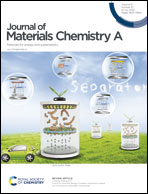Supported Cu3 clusters on graphitic carbon nitride as an efficient catalyst for CO electroreduction to propene†
Abstract
The electroreduction of carbon monoxide (COER) to multi-carbon (C2+) products has been emerging as a promising strategy for generating value-added fuels and chemicals, yet the development of efficient catalysts for this process still remains a huge challenge. Herein, by means of density functional theory (DFT) computations, we explored the catalytic performance of several sub-nano Cu clusters (Cun, n = 1–6) supported by graphitic carbon nitride (Cun@g-C3N4) for the COER. Our results revealed that the COER catalytic activities of these candidates are greatly dependent on the sizes of the anchored Cu clusters, among which Cu3 clusters were predicted to be the best COER catalyst with a rather low limiting potential of −0.45 V for CH4 production due to their optimal binding strength with reaction intermediates. More interestingly, at high coverage, the adsorbed CO* species can couple with each other to form a key CO–CO–CO* species via a one-step concerted trimerization mechanism with a small activation barrier of 0.43 eV, which can be further hydrogenated to propene products with a small limiting potential of −0.40 V. Thus, the anchored Cu3 cluster on g-C3N4 is a quite promising catalyst for the COER with high efficiency to multi-carbon products, which offers useful guidance to further design sub-nano cluster-based catalysts for other electrochemical reactions.



 Please wait while we load your content...
Please wait while we load your content...